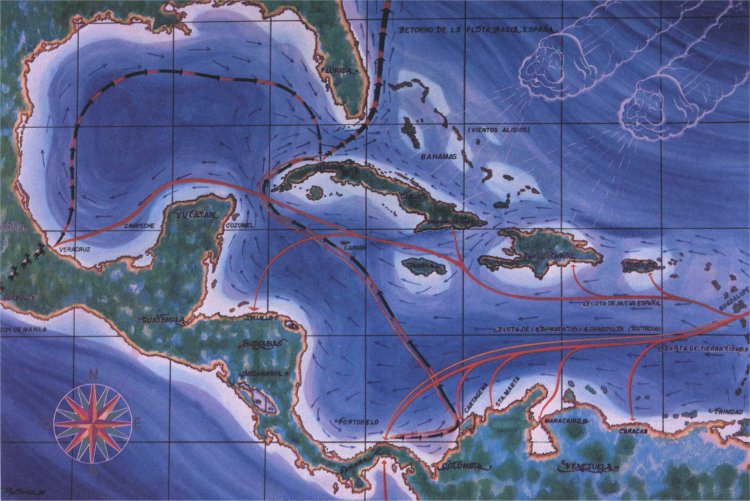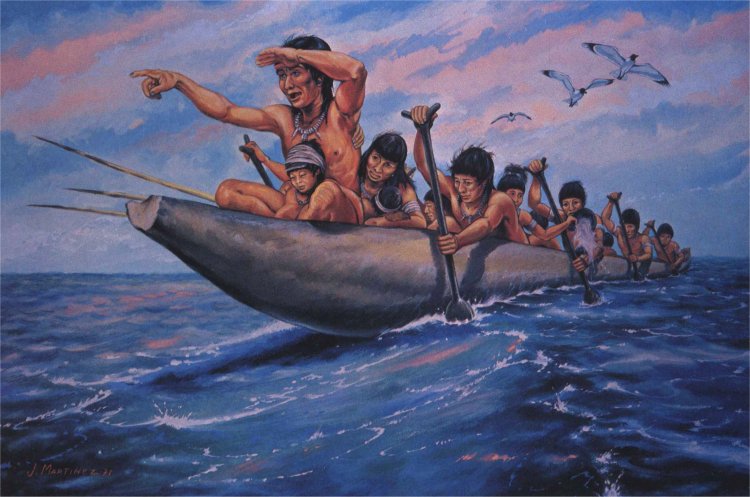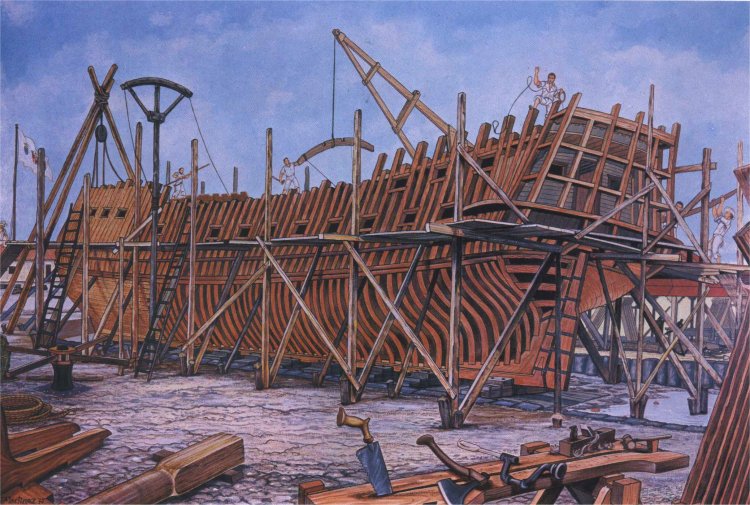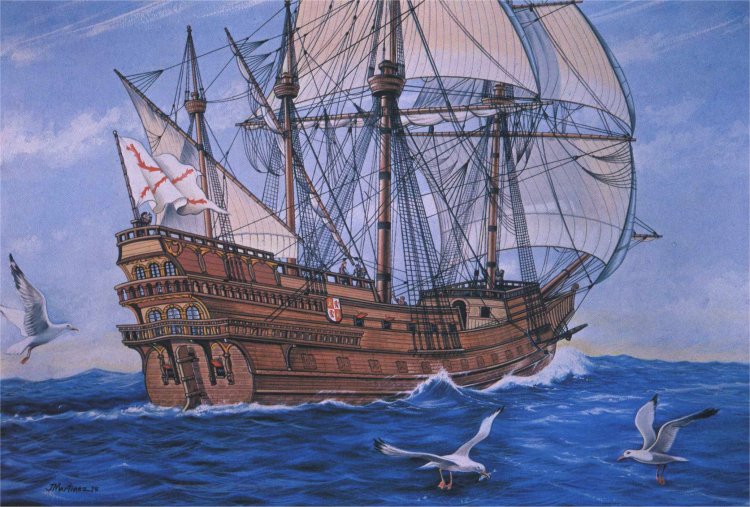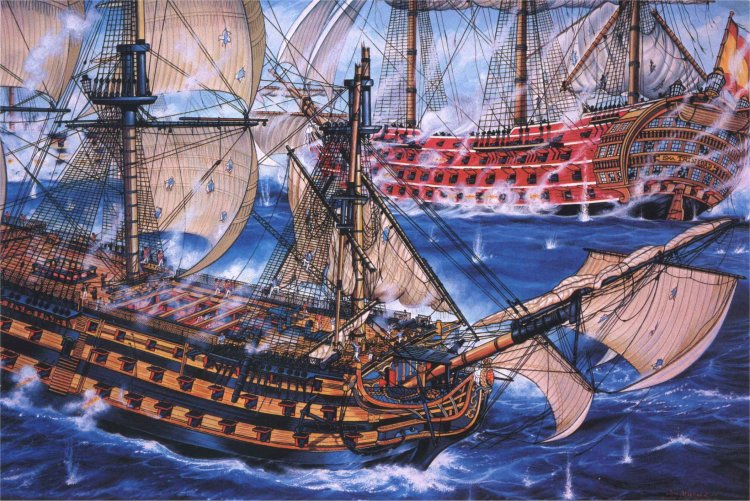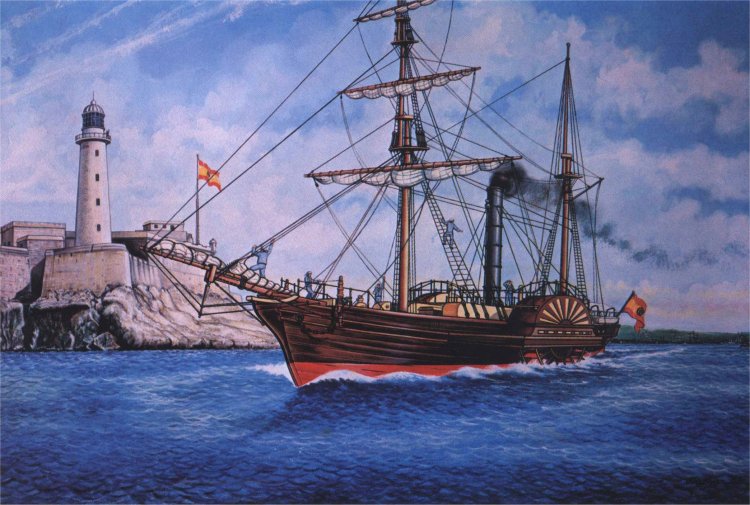A maritime history of Cuba
|
Early trade routes |
Throughout the long history of the island of Cuba, boats and ships of all kinds have played an extremely important role. Aboriginal immigrants came by canoe; Europeans, led by Columbus, first discovered Cuba in 1492 and subsequently explored the island by boat. Ships and harbors were crucial to the colony's commercial development. By 1519 the island was already serving as the base for Spanish explorations of the Americas.
During Cuba's late nineteenth century wars of independence from Spain, Cuban soldiers in exile landed by boat; and it was a converted yacht, the Gramma, that brought Fidel Castro and the nucleus of the guerrilla army to Cuba from Mexico late in 1956, thus beginning the struggle that culminated in the overthrow of Batista and the establishment of the Revolutionary Government.
The primitive boats which were constructed and used by the pre-Columbian groups that initially populated Cuba were canoes and piraguas. These vessels were used both for trade and transport, plying the open seas, coastal waters, and navigable rivers of the Cuban archipelago. Today, only a single oar from this period has been preserved. Thus, whatever is known about the size, construction, and use of these aboriginal craft has been learned from the reports of early explorers and chroniclers.
Columbus, for example, wrote in his diaries of having seen canoes capable of carrying as many as 150 persons. He also mentioned seeing many others - some so small that only one or two persons could be accommodated. The most complete descriptions of these early craft come from an early chronicler, Fernandez de Oviedo, who wrote:
There is a type of boat that the Indians call canoas, and with which they navigate both the larger rivers and the neighboring seas; they serve for their wars and attacks and for going from one island to another, as well as for fishing and other uses. Each canoa is made from a single log or tree, which the Indians carve out with hatchets made of stone. With these hatchets they chop and mash the log, hollowing it out. They burn out what has been chopped and mashed, little by little extinguishing the fire. Then they begin to chop and mash as before. Thus they continue, constructing a craft that almost has the shape of a washtub, but is deep and long and narrow, as large and thick as the length and breadth of the tree permits. The bottom is rounded and smooth, and - unlike our craft - it has no keel.
|
Dugout canoe |
Oviedo continued:
Sometimes they row standing up, other times seated, and other times kneeling. Their oars are like long spades, with tops like a cripple's crutch. Some of the canoes are so small that they hold only two or three Indians; others hold six, and others ten or more according to their size. But all of the craft are very light and very dangerous because they frequently capsize; but they never sink even when they fill up with water; and since these Indians are fine swimmers, they right the craft and very nimbly bail them out.
Oveido offers no more information, but at one point, Las Casas mentions in his chronicles that "the royal canoes are brightly painted, but the others have no color."
The final reference we have concerning the use of canoes of this type in Cuba dates from the mid-nineteenth century. In 1847, Rodr{guez Ferrer made an expedition to Cabo Cruz in what is now Gramma Province, in the eastern part of Cuba. He wrote that he and his companions passed the night at a small settlement at the cape and then sailed in two canoes to explore some nearby caves: 'These canoes were made from cedar, from a single log in the form once used by the Indians. The one in which I traveled was long enough to hold sixteen men, was about four feet wide, and was rowed as the Indians did, with short oars or paddles that they call canaletas." Although native craft became increasingly rare after Cuba was settled by the Spaniards and the indigenous civilizations were decimated, there was no lack of maritime activity on and around the island.
Beginning in the sixteenth century, the typical ship that sailed the waters around Cuba and the Caribbean was the galleon, a vessel originally deriving its name from the galley or oar-propelled craft of antiquity. The displacement of the early galleons ranged between 100 and 600 tons, but by the end of the century some had reached almost 1,000 tons. They were big-bellied ships, with high forecastles and quarterdecks, useful for their cargo capacity and with ample deckspace for cannons. On the other hand, they were slow, difficult to handle, and not particularly seaworthy. In the seventeenth century, galleons became even larger, carried more sail on their three masts, and were better adapted for the long voyages they were called upon to make. By then, some were three-deckers, and their armament was considerably augmented to include cannons along their sides as well as at the bow and stern.
|
Royal Shipyard of Havana in the mid-18th century, the period of its greatest activity. |
Early in the sixteenth century the Spaniards had established a fleet system (flotas) to take advantage of Atlantic winds and currents to carry the riches of the New World to Spain. The main reasons for the system were not, however, navigational. Rather, the system was set up to ward off the continual attacks of corsairs and pirates and to prevent unauthorized sailings from uncontrolled ports, and cargoes not registered with the royal Casa de Contración in Seville.
In 1561, King Philip II of Spain ordered the reorganization of the fleet system that had previously been established by Carlos V. Three fleets were created: the Flota de Nueva España, the Flota de Tierra Firme, and the Flota de la Guardia de las Indias. The first two consisted of anywhere from fifteen to forty-five ships: merchant ships, two armed galleons, other warships, and two or three "pataches," smaller, craft used for scouting and communications. The third fleet was composed of about eight armed galleons.
The three fleets sailed roughly the same course across the Atlantic from Spain, but after entering the Caribbean - usually near the island of Guadeloupe - each followed different routings. The Flota de Tierra Firme dispatched merchant ships to several ports on the northern coast of South America: Caracas, Maracaibo, Santa Marta, Cartagena, and others. The rest of the fleet then continued on to Porto Bello on the isthmus of Panama where it was joined by the Flota de la Guardia de las Indias. There the two fleets took on the riches that had been brought from the Port of Callao in Peru by the Flota de la Armada del Mar del Sur.
In like manner the Flota de Nueva España dispatched ships to ports in Puerto Rico, Santo Domingo, Santiago de Cuba, and other places, and then continued on to Veracruz on the eastern coast of Mexico. There the fleet loaded the treasure of Mexico, as well as the merchandise, textiles, gold and precious stones brought overland from the Pacific port of Acapulco. These goods, in turn, had been brought to Acapulco by the Manila galleons - also known as the China ships or the "nave de Acapulco" - craft which sailed from the Philippines to Mexico laden with goods from Egypt, Arabia, Persia, India, Japan, and the Philippines themselves.
|
A typical 17th century galleon used in New World trade, larger and better armed than earlier vessels. |
From Veracruz and Porto Bello, the fleets set sail for Havana. From Porto Bello the Flota de Tierra Firme and the Flota de la Guardia de las Indias first returned to Cartagena on the eastern currents. There they anchored for eight or ten days, collected the Crown's taxes, and regrouped with the merchant ships that had stopped at the various northern ports of South America. From Cartagena the fleet then sailed northwest, past Jamaica, the Cayman Islands, the Isle of Pines, through the straights of Yucatan, and on to Havana. The route of the Flota de Nueva España was also somewhat indirect. Since Veracruz lies downwind from Cuba, the fleet first turned north, sailing up the Gulf of Mexico until it was well above the southern tip of Florida. Then it sailed east, turning south during the last part of the voyage to Havana.
Once safely in Havana, refitted and restocked, the three fleets sailed together for Spain, heading north to catch the Gulf Stream and sailing between the Bahamas and the coast of Florida. From there they proceeded northeast to about the thirty-eighth parallel, catching the strong northern winds which carried them to the Azores and then to Spain. This was basically the pattern which dominated Spanish trade with the New World from the middle of the sixteenth to the middle of the seventeenth centuries. With some modifications, the Spanish fleet system continued for another hundred years. But then, with the decline of Spain and the mineral riches of the Americas fast becoming exhausted, the fleets were no longer viable, and a system of individually registered ships and free routing took its place.
Within a brief period at the end of the sixteenth century, Havana, owing to its geographical location, fine woods, and talented shipwrights, had become the foremost shipbuilding center of the Antilles. Not only did the Havana shipyard reliably construct vessels according to established designs, but it also became a place where important modifications in naval construction were developed. In the beginning of the eighteenth century, as the fleet system was nearing its end, the art of ship design was becoming influenced by scientific and mathematical considerations. Reflecting these developments, in 1720 Antonio de Gaztaneta published a work in Havana entitled "Proportions of the Most Essential Measurements for the Construction of Warships Carrying from 80 to 100 guns." In fact, his plans had been used as early as 1712 for local construction. It was in this context that the shipyard of Havana became one of the most important in the New World during the eighteenth century. From 1724 to 1796, 133 ships were constructed in Havana, among them 60 large craft, 8 of which were three-deckers carrying between 112 and 120 guns.
|
Santísima Trinidad, the biggest ship in the world, with four decks and 140 guns. |
To get an idea of the importance of naval construction in Havana during this period, it is useful to recall that the city itself had only 20,000 inhabitants and of these 759 worked in the shipyard. In this era of greatest productivity, approximately 15 million cubic feet of wood were used. As an example of the kinds of ships that were constructed and the uses to which they were put, the biographies of two of the more famous are illuminating. In 1749 the San Pedro, also known as the Rayo (lightning bolt), was launched. One hundred and eighty feet long, with a 55-foot beam and a draft of 28 feet, the San Pedro displaced almost 2,000 tons and mounted 80 cannons. Although constructed for commercial purposes by the Royal Trade Company of Havana, she saw more service in war than in peace. For more than fifty years she sailed the waters of the Caribbean, the Atlantic, and other seas, fighting in the Battle of the English Channel under Don Luis de Córdova, and elsewhere. At the turn of the century she was modified by the addition of yet another gun deck, making her a three-decker capable of carrying one hundred cannons. Under the command of Don Enrigue MacDonnell, she fought for the last time at Trafalgar. Although damaged, she survived the battle, only to meet her end in a storm off the coast of Spain, finally sinking near Cadiz on October 23, 1805, fifty-six years after her launching.
Another famous ship constructed in Havana during this period was the Santisima Trinidad (Holy Trinity). Larger than the San Pedro, she was a three-decker when launched in 1769, mounting 112 cannons, 214 feet overall, with a 58-foot beam and a 29-foot draft. Modified several times, she was eventually lengthened to 230 feet, and at the end of the century a fourth deck was added, allowing her to mount 140 cannons. A formidable man-of-war in her time, she was described by a young midshipman who served aboard her in the Battle of Trafalgar in the following fashion:
The Santisima Trinidad was a four-decker; the biggest ships in the world had only three decks. This colossus was built in Havana in 1769 of Cuba's richest woods. She saw thirty-six years of honorable service. The interior was a marvel of various compartments, with decks for the armament, quarters for the crew, holds for supplies, cabins for the officers, a galley, medical ward, and much more. I was fascinated running through the galleries and corners of that palace of the sea. The chambers situated in the stern resembled, from the inside, a palatial villa and from the outside seemed a kind of fantastic fortress. The balconies and the pavilions at the corners of the stern were like the lanterns of a castle, large turrets open to the sea from which you could see threequarters of the horizon. But nothing was grander than the rigging, with those huge masts thrusting toward the sky like a challenge to the storms. It seemed as if the wind would not have enough force to fill the enormous topsails. I became dizzy contemplating the immense web formed by the yardarms, shrouds, stays, braces, lifts, and halyards that sustained and moved the sails.
During the Battle of Trafalgar the Trinidad, commanded by Don Baltasar Cisneros, fought valiantly against the Victory, the flagship of Admiral Nelson. In extremely bad condition after the battle, she sank abruptly seven or eight leagues to the south of Cidiz. Thus ended the career of the pride of the Havana shipyard, "The Great Four Decker," as she was called by the English.
The defeat of the Franco-Spanish fleet at Trafalgar cost Spain the better part of her navy. Lost in combat or captured by the English were many of the finest vessels constructed in Havana. The naval disaster at Trafalgar, Spain's subsequent struggle against the Napoleonic invasion, and the loss of the majority of her American colonies (save Cuba) in the 1820s, made it impossible for Spain to reconstruct her fleets. The naval base at Havana fell into disuse. The shipyard, minimally active and only occasionally building vessels, was basically engaged in hauling and repairing those craft that passed through the port.
|
Sidewheeler Colon (Columbus) launched in 1851. |
Although the naval base was abandoned and other activities slackened, a fine slipway was inaugurated in 1850, and a year later two steam-powered craft, the Congreso (Congress) and the Colon (Columbus) were launched in Havana. The Colon was a sidewheeler, designed as a warship, driven by sails in addition to her 350 hp engine, and carrying six guns. Destined for Spain, she participated in various naval actions in the 1850s and '60s.
But there was not to be a renaissance of shipbuilding on the island, and the Colon was the last major vessel constructed in Cuba for more than 100 years. Shortly after her launching almost all naval construction in Cuba ceased. By the time Cuban independence was finally won from Spain at the turn of the present century, the once proud Havana shipyard was little more than a warehouse. With the advent of the Republic, and with the naval tradition all but forgotten, the lands where the shipyard once stood were sold. A railroad terminal was subsequently constructed on the spot where the sights, sounds, and smells of a grand tradition of maritime construction once held sway. It was a tradition that lay dormant until the revolutionary government came to power in 1959.
[The above was adapted from "Oceans, volume 10, number 5, and was written by Roger Montañés, a marine archaeologist for the government of Cuba, and illustrated by José Martínes, formerly head of the Photography Department of the Cuban Academy of Science.]

